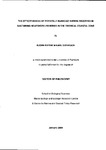THE EFFECTIVENESS OF PRIVATELY MANAGED MARINE RESERVES IN SUSTAINING NEARSHORE FISHERIES IN THE TROPICAL COASTAL ZONE
| dc.contributor.author | SVENSSON, BJORN PATRIK MIKAEL | |
| dc.contributor.other | Faculty of Science and Engineering | en_US |
| dc.date.accessioned | 2013-09-13T11:28:59Z | |
| dc.date.available | 2013-09-13T11:28:59Z | |
| dc.date.issued | 2009 | |
| dc.identifier | NOT AVAILABLE | en_US |
| dc.identifier.uri | http://hdl.handle.net/10026.1/1699 | |
| dc.description.abstract |
There is an emergent need to increase protection of nearshore resources from a growing human population, which is deteriorating coral reef ecosystems through coastal development, overfishing and destructive fishing practices. A possible solution involves increasing the number of smaller Marine Protected Areas (MPAs), creating a network of reserves with greater fisheries potential, while locally remaining small enough not to overly impinge on fishers available fishing grounds. Coral reefs are often found in developing countries, where governments financially struggle to establish successfully managed MPAs. A growing number of Hotel Managed Marine Reserves (HMMRs) have partly therefore, recently been established. Hotels arguably often have adequate funding, resources, and incentive to protect adjacent coastal areas - an HMMR could allow hotels to establish a market niche for a growing environmentally aware tourist. The principals of an Ecosystem-based Management (EBM) approach was adopted to test protection potential of an HMMR in Vietnam (Whale Island Resort: WIR) from a biological and socioeconomic point of view. Biannual visual fish census surveys (October 2005-April 2007) were conducted at the two marine reserves adjacent to WIR. The 6-year protected Whale Island Bay Reserve (WIB: 11 ha) showed significantly higher fish densities, richness, average size and number of fish >15 cm compared with two unprotected control sites. Fish stocks at the second, newer reserve, Whale Island Bay Peninsula Reserve (WIBP: 5 ha), quickly increased following protection. Fish assemblages at the 5 Artificial Reefs (ARs), made from clay pots (AR areas: 4.2-14.9 m^) in WIB, were greater than adjacent area-equivalent Natural Reefs (NRs) (11.15 greater biomass). showing larger fish assemblages with increasing AR size, adding to local fish stocks enhancement. Surveys were conducted with local fishermen to gauge socioeconomic impacts and management performance of the HMMRs. Fishermen mainly dependent on beach seining mostly opposed the HMMRs, while fishermen using other fishing techniques were generally in favour of the HMMRs, welcoming more protection and confirming spillover of fish, including large food fishes. In a Willingness to Pay (WTP) survey (n=211). 97.5 % of tourists at WIR supported HMMRs and 86.3 % were willing to pay an extra 10 % of the average room rate to stay at such hotels. In a worldwide survey of existing HMMRs, protecting areas from 1-700 ha (average 110 ha +/-13.22 SE), the average management rating attained was high (Good - HMMR is enforced). The accumulated findings from WIR and HMMRs globally, support the great potential of HMMRs as an added tool to protecting a part of our nearshore natural resources. | en_US |
| dc.language.iso | en | en_US |
| dc.publisher | University of Plymouth | en_US |
| dc.title | THE EFFECTIVENESS OF PRIVATELY MANAGED MARINE RESERVES IN SUSTAINING NEARSHORE FISHERIES IN THE TROPICAL COASTAL ZONE | en_US |
| dc.type | Thesis | |
| plymouth.version | Full version | en_US |
| dc.identifier.doi | http://dx.doi.org/10.24382/3253 |
Files in this item
This item appears in the following Collection(s)
-
01 Research Theses Main Collection
Research Theses Main


